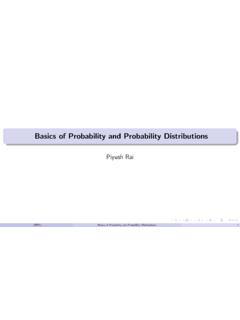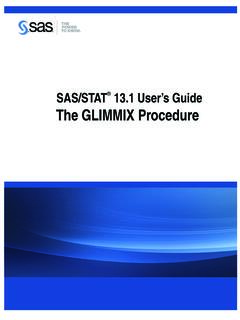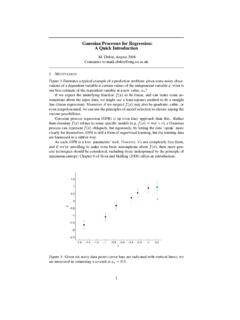Transcription of Pattern Recognition and Machine Learning by Bishop
1 Solutions to Pattern Recognition and Machine Learning by Bishoptommyod@ githubFinished May 2, updated June 27, document contains solutions to selected exercises from the book PatternRecognition and Machine Learning by Christopher M. in 2006, PRML is one of the most popular books in the field of machinelearning. It s clearly written, never boring and exposes the reader to details withoutbeing terse or dry. At the time of writing, the book has close to 36 000 citationsaccording to short chapter summaries are included in this document, they are not in-tended to substitute the book in any way. The summaries will largely be meaninglesswithout the book, which I recommend buying if you re interested in the subject. Thesolutions and notes were typeset in LATEX to facilitate my own Learning hope you find my solutions helpful if you are stuck.
2 Remember to make anattempt at solving the problems yourself before peeking. More likely than not,the solutions can be improved by a reader such as yourself. If you would like tocontribute, please submit a pull request similar projects exist: there s an official solution manual, a repositorywith many solutions a detailed errata located 1: The front cover of [ Bishop , 2006].1 Contents1 Chapter Introduction .. Probability Distributions .. Linear Models for Regression .. Linear Models for Classification .. Neural networks .. Kernel methods .. Sparse Kernel Machines .. Graphical Models .. Mixture Models and EM .. Approximate Inference .. Sampling Methods .. Continuous Latent Variables.
3 Sequential Data .. Combining Models ..302 Introduction .. Probability Distributions .. Linear Models for Regression .. Linear Models for Classification .. Neural networks .. Kernel methods .. Sparse Kernel Machines .. Graphical Models .. Mixture Models and EM .. Approximate Inference .. Sampling Methods .. Continuous Latent Variables .. Sequential Data ..8621 Chapter summariesNotationScalar data is given byx= (x1,..,xN)T, whereNis the number of samples. Vectordata is given byX, which has dimensionsN M, whereNis the number of data points(rows) andMis the dimensionality of the feature space (columns).MathematicsSome useful mathematics is summarized here, also see the book appendix.
4 Thegamma function (x) satisfies (x) = (x 1) (x 1), and is given by (x) = 0ux 1e s a continuous factorial, which is proved by integration by parts and induction. TheJensen inequalitystates that, for convex functionsf( j jxj) j jf(xj),where j j= 1 and j 0 for IntroductionProbabilityThe joint probability is given byp(x,y), which is short notation forp(X=xi Y=yj). The sum rule isp(x) = yp(x,y) = p(x,y)dy. Applying the sum rule as above is called marginalizing outy. The product rule isp(x,y) =p(x|y)p(y). Computingp(x|y) is called conditioning ony. Letwbe parameters andDbe data. Bayes theorem is given byp(w|D) =p(D|w)p(w)p(D) posterior =likelihood priorevidence. Frequentist: dataDgenerated from a fixedw. Bayesian: dataDfixed, find bestwgiven this Frequentists generally quantify the properties of data driven quantities in light ofthe fixed model parameters, while Bayesians generally quantify the properties ofunknown model parameters in light of observed data.
5 See [VanderPlas, 2014].Expectation and covarianceLetxbe distributed with densityp(x), then The expectation of a functionf(x) defined overxwith probability densityp(x) isE[f] = jf(xj)p(xj) = f(x)p(x)dx The variance off(x) isvar[f] =E[(f E[f])2]=E[f2] E[f]2 The covariance ofxandygiven bycov[x,y] =Ex,y[(x E[x])(y E[y])] The covariance matrix has entries ijcorresponding to the covariance of variablesiandj. Thus =Imeans no covariance. (Note that real data may have nocovariance and still be dependent, have predictive power,xj=f(xk) wherefisnon-linear. See Anscombe s quartet on Wikipedia.)Polynomial fittingLety(x,w) = Mj=1wjxjbe a polynomial. We wish to fit this polynomial to valuesx= (x1,..,xN) andt= (t1,..,tN) a degreeMpolynomial fittingNdata points.
6 The maximum likelihood solution is to minimizeE(w,x) N n=1[y(xn,w) tn]2. Regularization adds a weight-dependent error so that E(w,x) =E(w,x) +E(w).For instance, Ridge minimizes the 2-norm: E(w,x) N n=1[y(xn,w) tn]2+ w 22 While LASSO (Least Absolute Shrinkage and Selection Operator) minimizes anderror with the 1-norm. Both are examples ofTikhonov multivariate gaussian is given byN(x| , ) =1(2 )D/2| |1/2exp( 12(x )T 1(x ))where is the mean and is the covariance. Working with the precision := 1issometimes estimationLetx={x1,..,xN}be a data set which is identically and independently distributed( ). The likelihood function for the gaussian isp(x| , 2)=N j=1N(xj| , 2).Estimates for the parameters = ( , 2) can be obtained by maximizing the likelihood,which is equivalent to maximizing the log-likelihood lnp(x| , 2).
7 Maximizing the likelihoodp(D|w) is equivalent to minimizingE=eTein polyno-mial fitting. Maximizing the posteriorp(w|D) (MAP) is equivalent to minimizing regularizedsum of squaresE=eTe+ selection Both model and model hyperparameters must be determined. Minimize the error over the test set. Balance bias and variance. High bias canlead to underfitting, high variance can lead to overfitting. Split data into training, testing and validation. If data is scarce, usingK-fold cross validation is an theory Assignxto a regionRj RMcorresponding to a classCj, which might or mightnot be the true class. Minimizing misclassification is done by assigningxto theCjwhich maximizes theposteriorp(Cj|x). This is equivalent to maximizing chance of begin correct.
8 Loss functionLk,jmay be used, the loss function assigns a penalty when the trueclass and the predicted class ,j6=Lj,kin general. Pick theCjwhichminimizes expected loss, pick the classCjwhich minimizes kLk,jp(x,Cj).5 Three general decision approaches in decreasing order of complexity: (1) inference withclass conditional probabilitiesp(x|Cj), (2) inference with posterior class probabilitiesp(Cj|x) and (3) discriminant (Ck,x)Ckinferencediscriminant functiondecisionInformation theory h(x) = lnp(x) measures the degree of surprise. The entropy is the expected surprised, defined asH[p] =E[h] = jp(xj) lnp(xj) = p(x) lnp(x)dxand measures how many nats are needed to encode the optimal transmission ofvalues drawn fromp(x).
9 Discrete entropy is maximized by the uniform distribution. Continuous (or differential) entropy is maximized by the gaussian . Conditional entropy is given byH[x|y] = i,jp(xi,yj) lnp(xi|yj) = p(x,y) lnp(xi|yj)dxdy,and we have that H[x,y] = H[y|x] + H[x]. The Kullback-Leibner divergence is given byKL(p q) = p(x) ln(q(x)p(x))dxand is interpreted as the additional information needed if usingq(x) to encode valuesinstead of the correctp(x). Probability DistributionsConjugate priors Since we know thatp(w|D) p(D|w) p(w)posterior likelihood priorwe seek probability density functions such that the left hand side and the right handside is of the same functional form. In other words, the likelihoodp(D|w) is fixed,6and we seek priorsp(w) such that posteriorp(w|D) is of the same functional idea is similar to eigenfunctions.
10 Example: Since the binomial distribution is proportional topk(1 p)n k, the Betadistribution, proportional top 1(1 p) 1, is a conjugate prior. The product ofthese distributions then ensures that the posterior is of the same functional form asthe prior in GaussianGaussianpin BinomialBeta-distributionpin Multinomial Dirichlet-distributionThe multidimensional gaussian Gaussians arise naturally in sumsx1+ +xNand averages, since whenN the sum is normally distributed by thecentral limit theorem. The multidimensional gaussian can be diagonalized by diagonalizing the precisionmatrix = 1, then exp(xT x) =exp(yTDy), whereD= diag(d1,..,dD). One limitation is the unimodal nature of the gaussian , it has a single peak. Partitioned N(x| , ), where = 1andx=(xaxb) =( a b) =( aa ab ba bb.)










